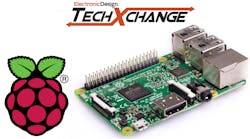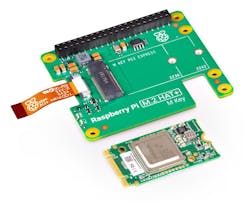Raspberry Pi 5 Taps into AI with a New Add-On Kit
What you’ll learn:
- What is the Raspberry Pi AI kit?
- How to use the kit.
We’ve seen the artificial-intelligence (AI) boom escalate for several years and it shows no signs of slowing. Nearly every industry is taking advantage of the technology, spurring innovation in everything from manufacturing to big-data analytics.
AI has also found its way into the development and maker markets, where users have utilized its advantages to build everything from robots to facial recognition systems. Furthermore, manufacturers are now integrating AI processing capabilities into their latest single-board computers and add-on boards for increased capabilities.
New AI Kit Aligns with Pi 5
The Raspberry Pi Foundation is just one of the institutions that’s taken advantage of AI for increased innovation with its new Raspberry Pi AI Kit. The kit, designed for use with the Raspberry Pi 5, the Foundation’s flagship board, allows users to experiment with a myriad of AI platforms.
>>Check out these TechXchanges for similar articles and videos
“Developed in collaboration with Hailo, the AI Kit offers an accessible way to integrate local, high-performance, power-efficient inferencing into a wide variety of applications,” said Raspberry Pi’s Naush Patuck. “It’s available now from our network of Raspberry Pi Approved Resellers.”
The kit includes Raspberry Pi’s M.2 HAT+ with a Hailo AI acceleration module (see figure). The AI module is a neural-network inference accelerator capable of pushing 13 TOPS (teraoperations per second). It’s built around the Hailo-8L chip, which uses the M.2 2242 form factor and comes preinstalled in the M.2 HAT+. The M.2 HAT+ provides a communication bridge between the AI module’s M.2 interface and the Raspberry Pi 5.
When connected, the Raspberry Pi 5 automatically detects the Hailo module and makes the neural processing unit (NPU) available for AI applications. This includes machine vision, which takes advantage of built-in “rpicam-apps” camera applications in the Raspberry Pi OS, facilitating post-processing tasks.
The kit also comes with preinstalled Hailo Tappas post-processing libraries, allowing users to create advanced AI applications with only a few hundred lines of C++ code. Software installation is made easy by incorporating a few packets via “apt” and then performing a simple reboot. On top of that, the Raspberry Pi AI Kit integrates an API into the GStreamer framework, along with native Python and C/C++ applications.
The Hailo-8L chip frees up the Raspberry Pi 5 CPU by offloading AI tasks directly on the module, suiting it for any number of AI applications. In addition, Hailo offers models for users to find pre-trained neural-network models optimized for the AI Kit. Raspberry Pi updated its AI framework to support the camera subsystem, which is documented in a “getting started” guide.
>>Check out these TechXchanges for similar articles and videos
About the Author
Cabe Atwell
Technology Editor, Electronic Design
Cabe is a Technology Editor for Electronic Design.
Engineer, Machinist, Maker, Writer. A graduate Electrical Engineer actively plying his expertise in the industry and at his company, Gunhead. When not designing/building, he creates a steady torrent of projects and content in the media world. Many of his projects and articles are online at element14 & SolidSmack, industry-focused work at EETimes & EDN, and offbeat articles at Make Magazine. Currently, you can find him hosting webinars and contributing to Electronic Design and Machine Design.
Cabe is an electrical engineer, design consultant and author with 25 years’ experience. His most recent book is “Essential 555 IC: Design, Configure, and Create Clever Circuits”
Cabe writes the Engineering on Friday blog on Electronic Design.





